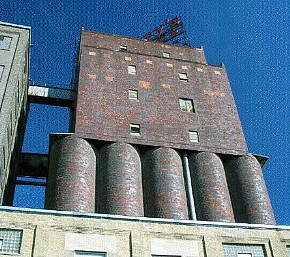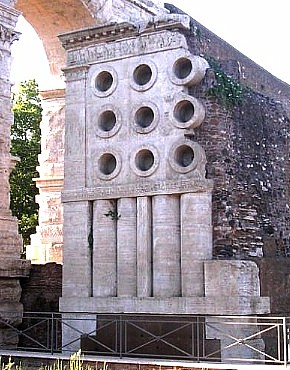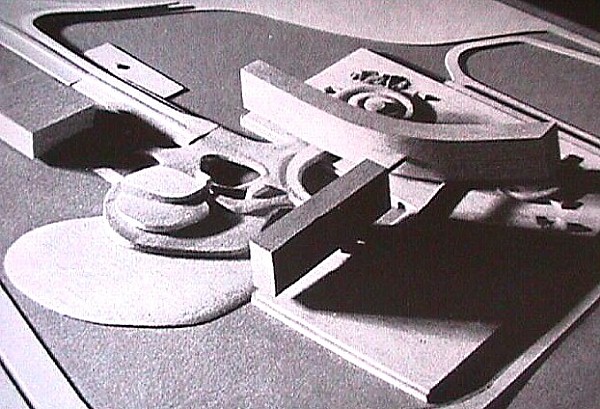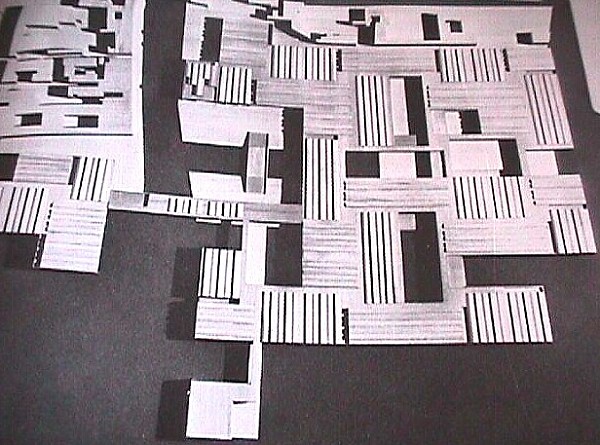2004.09.23 15:20
MVRDVs Serpentine
Take a look at Le Corbusier's Palais des Congrès à Strasbourg (1964), and then look at OMA's Hotel at Agadir, the Library at Jussieu, the Educatorium, and then MVRDV's VPRO--a trail of design reenactments. Maas worked on the OMA projects.
2005.02.26 13:01
Re: guthrie decon

This architecture immediately reminded me of the ancient Roman Tomb of Eurysaces (circa 30 BC).

I see reenactionary architecturism here in a funny kind of way. Given Le Corbusier's admiration of grain silo architectures, can the Tomb of Eurysaces be seen as an unlikely precursor of the whole "box raised on pilotis" paradigm? The holes in the tomb 'box' also remind me of Koolhaas' House in Bordeaux, which is indeed a reenactionary riff off the 'box raised on pilotis' paradigm.
| |
2005.04.08 11:43
modernity/post-modernity
As soon as the inhabitants of Pessac began to alter the appearance of their homes counter to the modern 'purism' of Le Corbusier's design, might just pinpoint the beginning of post-modern architecture.
2005.05.04 13:29
hejduk?
John Hejduk is definitely among my favorite architects. I met him once in Philadelphia, and got to take care of his slides before a lecture he gave in 1979--the sneak preview of his latest work then was indeed thrilling. I see Hejduk's work (of the late 1960s/early 1970s) as a distinct creative extension of Le Corbusier's late work, specifically the Carpenter Center at Harvard, the Palais des Congrès at Strasbourg (unexecuted), and the Governor's Palace at Chandigarh (unexecuted). (Not until last night did) I see The Berlin Masque as a design related to Piranesi's Ichnographia Campus Martius, and, perhaps it is Hejduk's architecture of Adjusting Foundations that fulfills Venturi's prediction (from the early 1980s within an issue of Casa Vogue, I think) that there will be patterns all over architecture in the near future.
And there's also Hejduk within the Maison Dom-ino Legacy (first published at Quondam 1997.08.18).
2005.05.06 17:24
Koolhaas versus the Actor
OK, I see what you mean, but...
There are many historical examples where architecture references itself, e.g., renaissance architecture referencing classical architecture, or even the second pyramid at Giza referencing the Great Pyramid at Giza.
Le Corbusier is just as much a reenactor as Stirling and the NY5 are reenactors. Le Corbusier reenacted machine forms and ship forms and American agricultural architecture forms. And Le Corbusier even ultimately reenacted himself--the Palais des Congrès (1964) reenacts the Villa Savoye (1929).
I don't buy the notion of there ever really being a split from the symbolic system. Degrees of separation, yes, but no real split.
Stirling is a consummate reenactionary architect, and he knew it, but he put most of his clues in his architecture only--although his entry for Roma Interrotta is an overt reference to Piranesi's Campo Marzio plan and reenactionary architecturism. Just as Rossi reenacted the Bustum Hadriani with the Modena Cemetery, but it doesn't look like he ever told Tafuri about it. Yes, Rossi was silent, as are most architects when it comes to telling others where their real 'originality' comes from.
2005.06.10 15:12
Which unbuilt project makes you fantasize?
...with regard to the two OMA projects you like [Oma's Agadir Hotel & convention Center in Morocco or Oma bibliòtheque in Paris], look very closely now at Le Corbusier's Palais des Congrès à Strasbourg, 1964 (unexecuted) for the true inspiration for both these projects.
I built a computer model of the Palais in 1990 and I/Arcadia - Architectural CAD Services published slides and drawings in 1991--Harvard's Loeb Library purchased both. I think Koolhaas subsequently saw this stuff there.
2005.09.14 14:07
Mat buildings
Now look at Le Corbusier's design for the Electronic Calculation Center Olivetti, Rho-Milan, 1963-64--it's got mat, blob and funky hi-rise all in one. The first to reenact this one was Stirling with his unbuilt design for the Olivetti Headquarters, Milton Keynes, 1971.


| |
2005.09.15 13:52
Mat buildings
Given that mat buildings have a strong precedent with Le Corbusier's design for a hospital of Venice, the notion of using similar mat buildings as part of the solution to New Orlean's architectural future isn't all that off the mark.

2005.11.14 09:11
favorite book on Arch[itecture]
Le Corbusier 1957-1965
Volume 7 of the Oeuvre Complète
Virtually all the architecture in this book proved to be well ahead of it's time.
2006.04.23 10:32
Steven Holl's building facades and urban patterns

You know, I always wondered what the urban pattern of Ronchamp was.
2006.04.23 12:45
Steven Holl's building facades and urban patterns
There doesn't seem to be any denying that Holl looked at and continues to look at the historical precedent of Le Corbusier's Ronchamp. Architects don't like to reveal their inspirations, so the bullshit starts coming out instead. The bullshit is essential to keep the myth of creative genius alive.
2007.07.17
Le Corbusier plans, etc.
In starting to do some cad apposition play tonight I found myself stifled by not knowing how to start. It seemed that the "right" plans were not at hand, and/or the scale of plans did not mix. In thinking about it now I should have just started with whatever was available and continued generating apposed plans one after another. As a result of not knowing what to do, I started to compile plans of Le Corbusier designs in the collection. I suppose I could start with apposing Corbusier plans, but I need to incorporate other (architect's) plans as well.
...the point of the appositions is to create whole new plans.
...utilize the cad data in a way that is original and/or unexpected and/or contrary to standard convention. First I should start with straight scale comparisons--via at least three plans--and from there begin the appositional compositions.
I was thinking that a 200 ft square quadrant could be the common denominator of all the scale appositional exercises, and then any exercise can easily relate/display with any other exercise.
|